Patchwork sewing allows you to create unique new things from old ones. To learn how to make unusual products, you need to know what fabric is best for making patterns, what sewing techniques exist, and also consider options for crafts that you can make with your own hands.
Patchwork for Beginners: Different Techniques and Patterns
Sewing from fabric scraps is a type of decorative and applied art, where small pieces of fabric are used to create beautiful items that are useful in the household and decorate the interior.
This art originated in England and gradually became known to the whole world. In hard times, when there was no abundance of materials, women sewed together scraps of old clothes to get new ones. The experience of patchwork sewing was passed down from generation to generation, various techniques and patterns appeared, as well as basic rules that are important for beginners and experienced craftsmen to follow.
Scroll:
- Correct selection of fabric. The material should match in color, theme of the drawing, as well as in density and texture. Most often, needlewomen use calico, denim and silk fabric.
- Accuracy. In order for the sewn product to look neat and beautiful, you need to follow the patterns and templates exactly. The pieces of fabric are cut strictly according to the ruler and stitched on the sewing machine, making the same indents for the stitching.
- Trial works. Experienced craftsmen recommend that beginners check the patterns of large products by sewing them in miniature. This will take time, but this method will help check the accuracy of the pattern, as well as detect difficult areas and find solutions to problems. It is difficult to correct errors on a large finished work, there is a risk of completely ruining the appearance of the product.
- Steaming and ironing. All products undergo several stages of heat treatment. First, the fabric is ironed before making patterns, then the cut out pieces are ironed, and after the work is completed, the craft is steamed.

The cutting and sewing method differs depending on the technique of making the product. The most popular patchwork styles are described in more detail below.
Bargello
Finished works in this technique look complicated, but in fact, it is one of the easiest ways to create a beautiful product from scraps. It is important to choose the right shades of materials, as well as learn to sew neatly, connecting the joints of fabrics as evenly as possible. Learning to sew in the Bargello style begins with making blocks from strips of fabric.
These elements are the basis for the finished work. The fabric is cut into even strips, with an allowance of 5 cm. The resulting strips are sewn together along the long edges with a regular machine stitch so that the seam remains on the wrong side. You need to start joining the strips from the bottom up. Before stitching the material, the strips need to be connected with tailor's pins along the edges.
Craftsmen recommend changing the direction of each new seam in the opposite direction. This reduces the risk of stretching or crumpling one of the ribbons "into an accordion". After the ribbons are sewn, you need to iron the seams from the inside so that they do not stick out. Then, from the resulting large block, cut out 4 small ones in the form of isosceles triangles.
These parts need to be folded into a square, connecting the tops of the triangle in the center and stitched. You will get a square fragment, sewn using the "strip to strip" technique. From such parts you can already assemble a pillowcase, a chair cover or a bedspread. To get a product in the "Bargello" style, the technique needs to be refined.
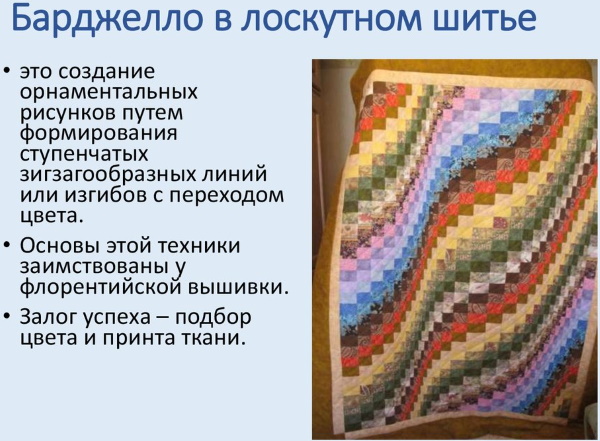
How to do it:
- Fold the fabric strips in half lengthwise and sew the edges.
- The resulting “bag” needs to be cut into strips of equal width vertically to obtain rings sewn from square patches.
- Now these rings need to be disconnected, following the "step" pattern. To do this, each subsequent ring is cut 1 square higher than the previous one.
- The strips are sewn together so that the seam lines remain even and the stepped pattern is preserved.
The result is a block in the "bargello" technique. All that remains is to cut off the excess and iron the fabric, bending the seams to one side.
Patchwork
Another simple technique for creating an unusual pattern from different scraps. In classic patchwork, simple patterns are used: squares, triangles, hexagonal and rectangular figures. Depending on the shape of the patterns, classic patchwork is divided into types.
The table describes the 5 most popular ones:
| Fast squares | Magic Triangles | Checkerboard | Watercolor | Stripe to stripe |
| The fabric is sewn into wide strips. The resulting fabric is cut crosswise into strips and connected again in a random order. | The patterns are in the form of isosceles, scalene or right triangles, from which more complex designs are laid out. | The products are made from 2 types of fabric. Square parts are connected in a checkerboard pattern. Seams can be inside or outside, with embroidery or fringe. | The patches are carefully selected by color, while simultaneously creating a pattern in which dark shades smoothly transition into light ones, imitating a watercolor drawing. | This technique is the basis for the "bargello" style. Strips of fabric are sewn together along the long edge. The blocks can consist of either straight lines or square blocks. |
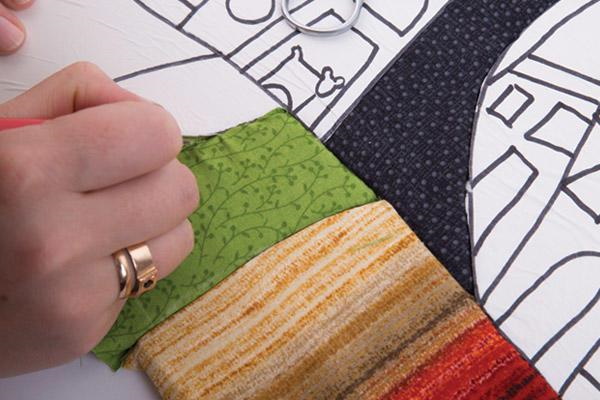
Professionals advise creating your first works in the classic technique. Large parts of simple shapes are easier to sew and assemble interesting patterns. When patchwork-style products start to turn out neat, you can move on to learning more complex techniques.
Pizza
Patchwork is a waste-free production. If after work there are small scraps of fabric of different colors and shapes, you can also create unusual colorful products from them. This technique is called "pizza" because the process of forming a pattern resembles laying out the ingredients of an Italian dish on dough.
The basis is a medium-thick fabric. Small scraps are sorted by color and randomly placed on the workpiece. To prevent protruding corners and threads from spoiling the pattern, a piece of transparent or tinted tulle or organza is placed on top and stitched with a parallel or cross stitch. The result is a bright and original pattern.
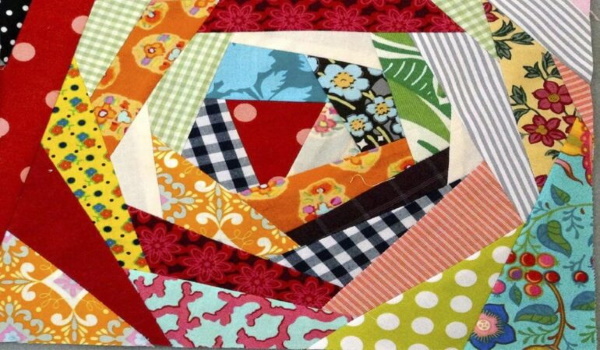
To assemble a large product, you will need to sew several blocks. Small pieces of fabric are sewn onto a lining that has been cut to shape in advance. Once finished, the edges are trimmed evenly, sometimes processed on an overlock.
Crazy
This sewing style, like "pizza", allows you to use the remains of fabric for creativity. Patterns are not needed here, the main thing is fantasy and beautiful design. This technique involves a chaotic combination of fabric of different textures, colors and patterns of various themes. In addition to irregular shapes, the seams in crazy sewing are decorated with embroidery or fringe.
Small patterns can be embroidered with braid or satin ribbon over the patches. Bead embroidery and interesting button compositions are welcome. The edges of the finished blocks are trimmed and aligned after the patches have been sewn on. To prevent the fabric from sticking out, the edges can be overcast on an overlock.
Boro
The "boro" technique is considered unique because it is based not on machine stitching, but on hand stitches. The fabric scraps are cut into rectangles and squares. They are placed in a random order. The joints should not be straight, the fabrics are laid out so that the edges overlap each other. Some scraps can be slightly unraveled at the edges.
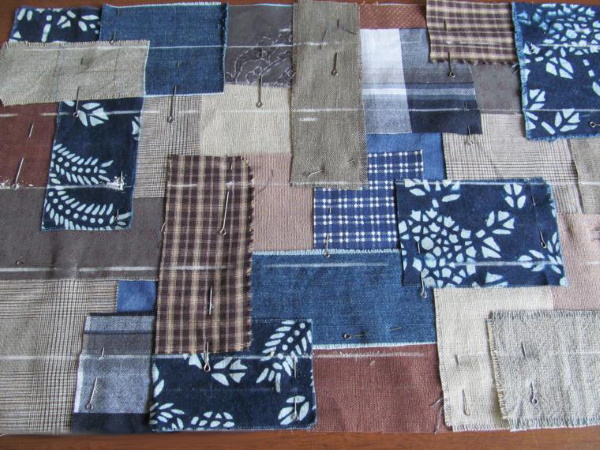
When the pattern is fully assembled, all the elements are pinned together. So that the patches do not come apart. Machine stitches are laid along the canvas at a distance of 5-10 cm from each other. Then take strong threads, preferably with a contrasting color in relation to the general plan, and stitch the canvas by hand, with forward stitches. In some places, you can embroider crosses.
Lyapochikh
Sewing from fabric scraps in the "lyapochikh" style gives the products an unusual fleecy look. The strips of material are placed on the backing in an unfolded form and stitched on the machine in the middle. Both ends of the tape are left free. The material is sewn tightly to each other in a row. Sewing starts from the bottom up. The larger the scraps, the more voluminous the product turns out.
In this technique, you can create 2 types of patterns: volumetric and color. It is believed that arranging fabric of different colors in the "lyapochikh" style is more difficult than in others. Most often, special markings are used for work. Volumetric patterns are obtained from long, interwoven patches.
American Quilting
This type of patchwork is considered a separate direction, the distinctive feature of which is volume and three-layer. A thin layer of synthetic padding is placed between the base and the patches, and then the fabric is quilted. Children's blankets, bedspreads and rugs are sewn in this style.
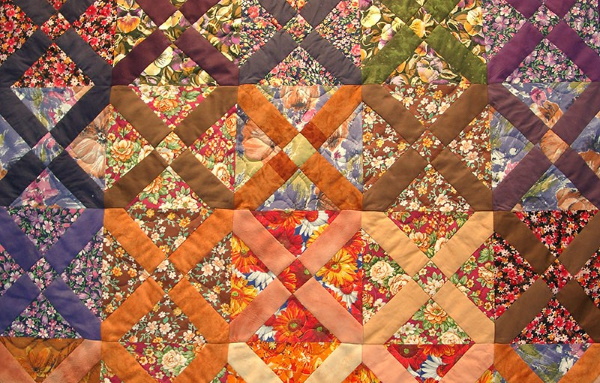
Fabrics for the front side are used in a single color and similar in texture. Patterns with a plot are welcome in quilting. A drawing is laid out from scraps and given volume by machine stitching along all lines.
Unusual things made by hand
Sewing from fabric scraps is a way to create original things that will not only decorate your home interior, but will also be functional and useful. More experienced craftsmen offer beginners to make their first small-sized works.
To try out different sewing styles, you need to practice making potholders, pillowcases, cosmetic bags and bags. Below you can see detailed instructions on how to create unusual things for your home from scraps.
Preparation of materials and tools
First of all, you need to select the fabric. It is desirable that the product consists of scraps of the same type of material. Using scraps of different textures, it is difficult to achieve a good result. The combined style is only suitable for sewing in the "crazy" and "pizza" techniques.
The table shows the names of the most popular materials for patchwork sewing, as well as their properties:
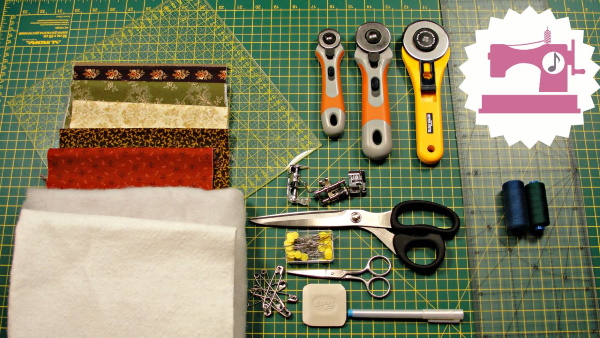
| Materials | Properties |
| Cotton | They do not shed, can be ironed, and shrink when washed in hot water. |
| Linen | Often used for lining. Does not shrink after washing, but wrinkles a lot. |
| Woolen | They do not wrinkle and retain their original appearance for a long time. |
| Viscose | They are easy to iron, but they lose their shape with frequent washing. |
| Synthetic | Iron carefully. The edges often crumble. They retain their shape for a long time and do not lose their color. |
It is important that the material matches in color scheme, as well as in the theme of the pattern. The most common types of patterns on fabric are floral, children's and geometric.
What tools need to be prepared for work:
- Sewing machine and overlock.
- Iron or steamer.
- Measuring instruments: tape measure, straight and triangular ruler.
- Scissors or rotary cutter.
- Tailor's pins.
To create and accurately redraw the diagrams, you will need graph paper with a grid.
Beautiful patchwork sewing of bags
Patchwork bags can be sewn in any style and shape.
This description of the work stages is suitable for the classic options:
- Make patterns for the sides, bottom and ends.
- For the backing, you need to use a thick material, such as denim.
- The patches are sewn onto the main fabric in any order, depending on the chosen style.
- The parts are connected into a single product.
- They attach locks, handles and other fittings.
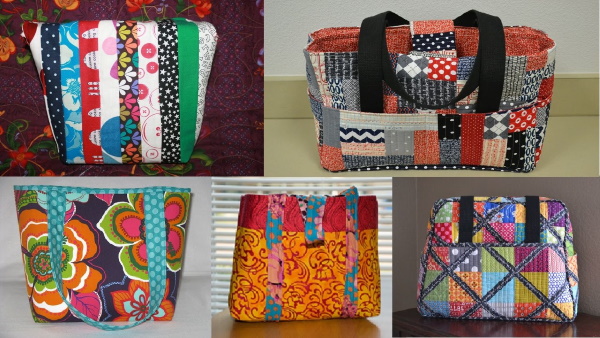
For beach options, you can use synthetic and cotton fabrics. For everyday options, leatherette is suitable. It is easier to care for, and the bag will last longer.
Patchwork rug made of jersey
Knitted fabrics make soft and bright rugs. To create them, needlewomen often use the "lyapochikh" technique.
An example of making a square rug in 5 colors:
- The prepared fabric is cut into pieces in the form of strips of the same size.
- As a base, you need to choose a dense material that will not slide too much on the floor.
- Use colored chalk or markers to make markings that will help you arrange the material evenly. An example of a pattern on an 80x80 cm base: a circle with a diameter of 20 cm in the center, 2 rings around it, each 7 cm wide, a frame that is 10 cm from the edge. The space between the rings and the frame will be filled with plain patches.
- With this pattern, it is easier to start work from the middle rather than from the bottom row. Therefore, with a spiral stitch from the center, the circle is filled with stripes stitched in the middle.
- The color is changed to a contrasting one and 1 ring is decorated, then the color of the fabric is changed again and the 2nd ring is stitched.
- Now fill the empty space up to the frame. Here you can start sewing in rows from below. The color can be new or the same as in the first circle.
- The frame is decorated with a darker fabric.
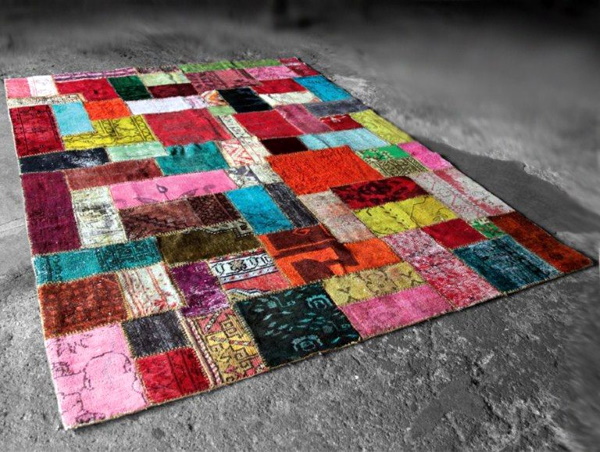
If the rug still slides on the floor, you can buy special rubberized corners. They are glued to the back of the product, and it will no longer slip or slip.
Blanket made from different scraps
Patchwork blankets are often made using the American quilting technique. To work, you will need cotton fabric for the base and for cutting out the patches, as well as thin synthetic padding for the backing.
Here is an example of sewing a children's blanket, measuring 140x90 cm:
- To make the product look more interesting, you can decorate its front side with a checkerboard pattern. It will consist of 126 square patches measuring 10x10 cm, 63 of which will be one color, and the remaining 63 - another.
- First, you need to sew the finished fabric. To simplify the task, you should cut out not squares, but strips 12 cm wide and 142 cm long (with seam allowances). You will need 9 of them. Accordingly, 4 of them are one color, 5 of another. The strips are sewn along the long edge, and then cut lengthwise into strips 10 cm wide.
- All that remains is to unfold the strips so that the squares are arranged in a checkerboard pattern and reconnect the fabric into a whole piece.
- Now cut out the base, put some padding polyester underneath, and cover it with a piece of scrap fabric on top. Stitch the blanket along the edges.
- Now you need to give the product a quilted look, for this, machine stitch along all the lines dividing the squares.
- The edges of the blanket can be trimmed with braid or soft lace.
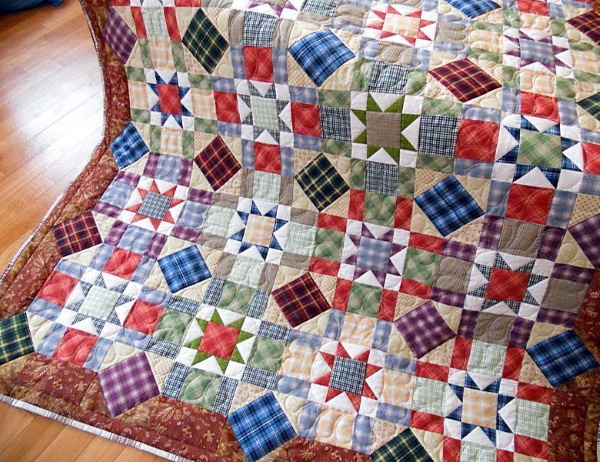
For baby blankets, it is better to use soft fabrics, such as flannel, with a children's print.
Patchwork bedspread
Bedspreads for a bed or sofa are made using a pattern similar to a blanket. For work, it is better to give preference to dense fabrics that are easy to wash and iron. Jeans, wool jacquard, bamboo will do.
The patches can be of different shapes: square, triangular or hexagonal. The main thing is to correctly compose the color pattern. Thick material can be sewn without lining, but to give the bedspread a more aesthetic appearance on both sides, cotton and viscose fabrics can be used as a backing.
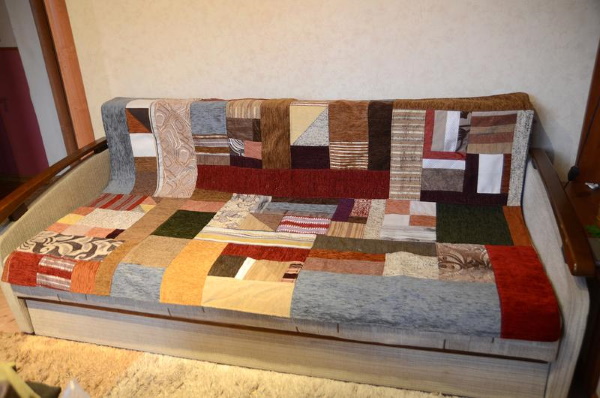
The patterns are connected in any order. Products assembled from prepared blocks look beautiful. To calculate the number of blanks, you need to divide the area of the bedspread by the area of 1 flap or block. At the end of the work. The edges are processed on an overlock or decorated with a tape of a matching color.
Stool covers
These items are sewn using a variety of techniques. The most popular design styles are: "pizza", "bargello", "American quilting".
Universal instruction:
- The seat of the stool is measured and a pattern is made from thick fabric, which will serve as the base.
- If the stool is square, then you need to sew laces to the lining at each corner, which will fix the cover. They are tied around the legs of the stool. For round seats, it is better to make a cover with an elastic band.
- Patches are sewn onto the lining in accordance with the chosen style. The excess is cut off, and the edges are finished with tape.
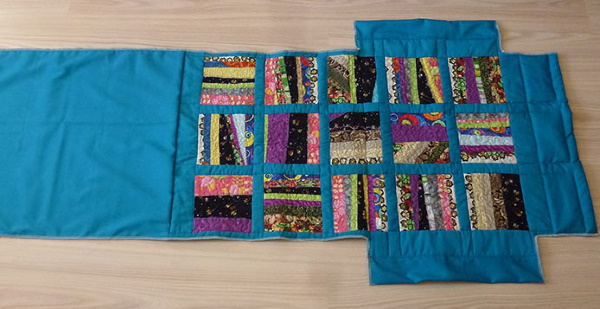
To sew an elastic band to a round product, you will need to make a border from synthetic fabric. To do this, cut out a strip 7 to 15 cm wide and sew it to the base. A wide elastic band is attached along the edges.
Toys from fabric scraps
Sewing from fabric scraps allows you to create more complex items, such as soft children's toys. They are mainly sewn using the classic technique, since the patterns are not standard, and a large number of decorative seams or small trims can spoil the appearance of the craft. Cotton, calico and flannel fabrics are used for sewing.
Experienced craftsmen can beautifully sew together fleecy and synthetic rags. Standard patterns are used as a basis for work, each part is made from a different material. Beginners are better off starting with flat products. Such toys are called "slappers" because they have the shape of a small pillow.
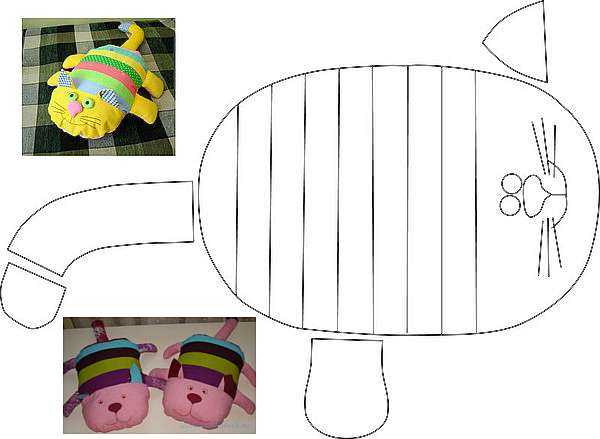
The details for such patterns are quite large, so the entire area of the toy can be filled with small patches. To decorate such crafts, use buttons, beads, and special fittings: plastic eyes and noses.
Patchwork is not difficult to master. It is important to start with simple works, gradually moving on to more complex ones. To create beautiful products, you can use new fabric, and also give a "second life" to old things, cutting out patches from clothes that are not suitable for wearing.
Video about sewing from fabric scraps
Textile items from fabric scraps:
